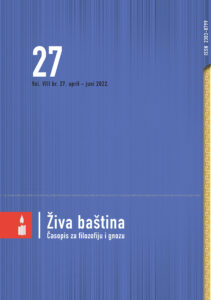UDK 28-291
821.163.4(497.6).09-1
U radu se razmatra komunikacija u ilahijama u svesci Ilahije ‒ poruke Seida Strika, istaknute ličnosti iz oblasti sufizma odnosno tesavvufa u Bosni i Hercegovini. Promatrano iz ugla komunikacije, pokušalo se odgovoriti na pitanje koje su to specifičnosti ilahija poredanih ukrug za koje autor publikacije navodi da je to praktikum tarikata. U ovoj publikaciji kao autori ilahija pojavljuju se: Ebu Bekr es-Siddik, Misri, šejh Sirri-baba sa Oglavka, Selim Sami, Derviš-paša Hercegovac, Derviš Kenan, a tu je i nekoliko ilahija nepoznatog autora. Svakako da su to oni počašćeni nadahnućem da pišu tekstove ilahija izdvajajući se po svojoj duhovnoj snazi. Iako prvobitno koncipirana kao publikacija za internu tekijsku upotrebu, oblikovana je tako da prikaže suštinu i dubinu zadatka putovanja sufijskom/tarikatskom stazom, pa bi se uz manje dorade mogla pretvoriti u priznatu literaturu vrijednu pažnje svakog sufije, derviša, početnika ili putnika na stazi.
Ovo nam otvara polje analize manje poznatog komunikacijskog aspekta ilahija koji sadrži sve važne oblike komunikacije i to sa simboličkim napredovanjem putem redoslijeda ilahija u kružnom toku. Petnaest ilahija označava etape puta i zatvara krug kretanja sufijskom stazom, počev od onih koje su strogo na osnovama intrakomunikacije a potom interkomunikacije, kakva je većinom vrsta onih ilahija koje daju savjete (nasihatske ilahije), zatim onih koji imaju mješovitu intra/interkomunikaciju, te onih upućenih ne samo pojedincu nego i grupi.
Ideja i cjelovita zamisao je da čitalac odnosno publika shvati dubinu tekstova i obrati pažnju na kvalitet komunikacije imajući na umu činjenicu da je ilahija dobar pratilac stanja na spoznajnoj stazi. Bio je potreban oprezan pristup da bi se na ispravan način prišlo ovim iskustvima napredovanja, koja u sebi nose i duhovno i praktično, te uspostavio balans odnosa teorijskog i praktičnog momenta.
Djelovanje ilahija na pojedince i grupe te samih učača zacijelo doprinosi nadahnuću različitog stepena, zavisno od sposobnosti i snage učenika/murida, recipijenta. Izbor ilahija, onih nakon obreda zikra, ali i onih u toku zikra ili zasebno, nikad nije slučajan. Najčešće se uči ona ilahija koja odgovara nekoj temi, naprimjer davanju savjeta/nasihata, ili se pak uzima ona koja bi mogla otvoriti neku temu o kojoj bi trebalo diskutirati i slično. Zatvaranjem kruga u ovoj publikaciji dobija se potpun utisak o postojanju dijelova duhovnog puta i o mogućem napredovanju, uspinjanju i padovima. Stoga je preporučljivo uvesti se na stazu putem ove i sličnih publikacija sagledavajući poruke koje one prenose.
Reception of the Form of Communication in Ilahiyas on the Example of Seid Strik's Publication “Ilahiyas and Messages”
Senella Krehić-Fočak
Abstract
The paper discusses the communication in ilahiyas in the Book of Ilahiyas-Messages of Seid Strik (1933-2010), a prominent figure in the field of Sufism, Tasawwuf, in Bosnia and Herzegovina. Observed from the point of view of communication, an attempt was made to define specifics of the ilahiyas arranged in a circle, which, according to the author of the book, is the practice of the tariqat. In the book, the following individuals appear as the authors of ilahiyas: Abu-Bakr el-Siddik, Misri, Sheikh Sirri-baba from Oglavci, Selim Sami, Dervish Pasha Hercegovac, Dervish Kenan, and there are also a couple of ilahiyas by an unknown author. It is certain that they were the ones who were honored with the inspiration to write the texts of ilahiyas and who stand out with their spiritual strength. Although originally conceived as a book for internal tekke use, it was designed to show the essence and depth of the task of traveling on the Sufi-Tarikat path, and, with minor refinements, it could be turned into recognized reading material, worthy of the attention of every Sufi, dervish, beginner or traveler on the path.
This opens up the field of analysis of the lesser-known communication aspect of ilahiyas, which contains all essential forms of communication, with a symbolic progression through the order of ilahiyas in a circular flow. Fifteen ilahiyas mark the stages of the path and close the circle of movement along the Sufi path: starting with those that are strictly based on intracommunication, then intercommunication, which is mostly the type of those that give advice – nasihat ilahiyas, then those that have mixed intra-intercommunication, and those addressed not only to an individual but to the group. The overall idea is for the reader, that is, the audience, to understand the depth of the texts and pay attention to the quality of communication, bearing in mind the fact that ilahiya is a good monitor of one’s condition on the cognitive path. A careful approach was needed in order to properly approach these experiences of progress, which carry both spiritual and practical aspects, and to balance the relationship between the theoretical and practical moments. The influence of ilahiyas on individuals and groups, as well as the influence of their performers themselves, certainly give rise to different degrees of inspiration, which depends on the ability and strength of the student/murid, the recipient. The choice of ilahiyas, those after the ritual of dhikr, as well as those during the dhikr or separate ones, is never random. Most often, the ilahiya that corresponds to a topic is performed; for example, giving advice – nasihat, or the one that could open up a topic that should be discussed. Closing the circle in the book gives a complete impression of the parts of the spiritual path and possible progress, ascents and falls. Therefore, it is advisable to get on the path with this book and other similar books, by looking at the messages they convey.
Keywords: ilahiya, communication, intracommunication, intercommunication, group communication
[tags]

